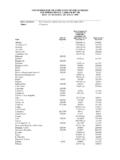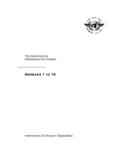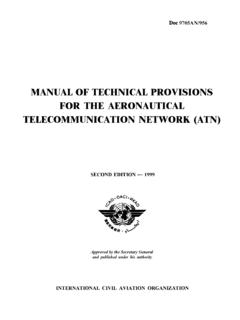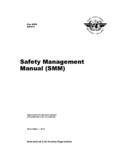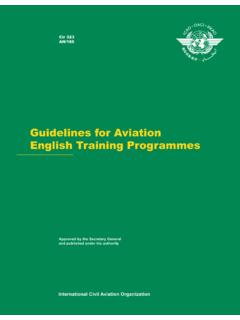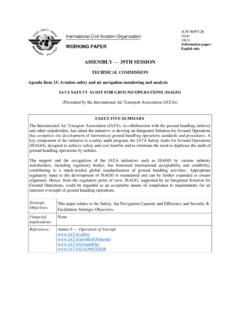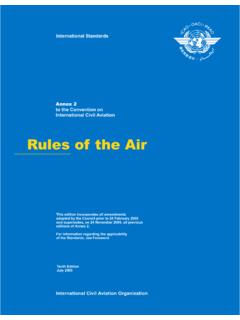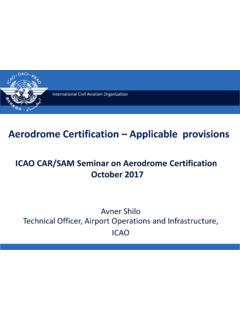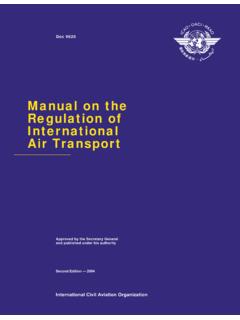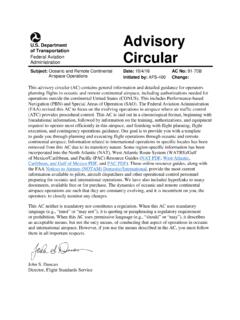Transcription of Performance-based Navigation (PBN) Manual
1 International Civil Aviation OrganizationApproved by the Secretary Generaland published under his authorityPerformance-basedNavigation (PBN)ManualThird Edition 2008 Doc 9613AN/937 International Civil Aviation OrganizationApproved by the Secretary Generaland published under his authorityPerformance-basedNavigation (PBN)ManualThird Edition 2008 Doc 9613AN/937 Published in separate English and French editions by the INTERNATIONAL CIVIL AVIATION ORGANIZATION 999 University Street, Montr al, Quebec, Canada H3C 5H7 For ordering information and for a complete listing of sales agents and booksellers, please go to the ICAO website at Third edition 2008 ICAO Doc 9613, Performance-based Navigation (PBN) Manual Order Number: 9613 ISBN 978-92-9231-198-8 ICAO 2008 All rights reserved.
2 No part of this publication may be reproduced, stored in a retrieval system or transmitted in any form or by any means, without prior permission in writing from the International Civil Aviation Organization. (iii) AMENDMENTS Amendments are announced in the supplements to the Catalogue of ICAO Publications; the Catalogue and its supplements are available on the ICAO website at The space below is provided to keep a record of such amendments. RECORD OF AMENDMENTS AND CORRIGENDA AMENDMENTS CORRIGENDA No. Date Entered by No. Date Entered by
3 VOLUME I CONCEPT AND IMPLEMENTATION GUIDANCE I-(iii) EXECUTIVE SUMMARY Background The continuing growth of aviation increases demands on airspace capacity therefore emphasizing the need for optimum utilization of available airspace .
4 Improved operational efficiency derived from the application of area Navigation (RNAV) techniques has resulted in the development of Navigation applications in various regions worldwide and for all phases of flight. These applications could potentially be expanded to provide guidance for ground movement operations. Requirements for Navigation applications on specific routes or within a specific airspace must be defined in a clear and concise manner. This is to ensure that the flight crew and the air traffic controllers (ATCs) are aware of the on-board RNAV system capabilities in order to determine if the performance of the RNAV system is appropriate for the specific airspace requirements. RNAV systems evolved in a manner similar to conventional ground-based routes and procedures.
5 A specific RNAV system was identified and its performance was evaluated through a combination of analysis and flight testing. For domestic operations, the initial systems used very high frequency omnidirectional radio range (VOR) and distance measuring equipment (DME) for estimating their position; for oceanic operations, inertial Navigation systems (INS) were employed. These new systems were developed, evaluated and certified. airspace and obstacle clearance criteria were developed based on the performance of available equipment; and specifications for requirements were based on available capabilities. In some cases, it was necessary to identify the individual models of equipment that could be operated within the airspace concerned.
6 Such prescriptive requirements resulted in delays to the introduction of new RNAV system capabilities and higher costs for maintaining appropriate certification. To avoid such prescriptive specifications of requirements, this Manual introduces an alternative method for defining equipage requirements by specifying the performance requirements. This is termed Performance-based Navigation (PBN). Performance-based Navigation (PBN) The PBN concept specifies that aircraft RNAV system performance requirements be defined in terms of the accuracy, integrity, availability, continuity and functionality, which are needed for the proposed operations in the context of a particular airspace concept. The PBN concept represents a shift from sensor-based to Performance-based Navigation .
7 Performance requirements are identified in Navigation specifications, which also identify the choice of Navigation sensors and equipment that may be used to meet the performance requirements. These Navigation specifications are defined at a sufficient level of detail to facilitate global harmonization by providing specific implementation guidance for States and operators. Under PBN, generic Navigation requirements are defined based on operational requirements. Operators then evaluate options in respect of available technology and Navigation services, which could allow the requirements to be met. An operator thereby has the opportunity to select a more cost-effective option, rather than a solution being imposed as part of the operational requirements. Technology can evolve over time without requiring the operation itself to be reviewed, as long as the expected performance is provided by the RNAV system.
8 As part of the future work of ICAO, it is anticipated that other means for meeting the requirements of the Navigation specifications will be evaluated and may be included in the applicable Navigation specifications, as appropriate. PBN offers a number of advantages over the sensor-specific method of developing airspace and obstacle clearance criteria, : a) reduces the need to maintain sensor-specific routes and procedures, and their associated costs; Performance-based Navigation (PBN) Manual I-(iv) Volume I. Concept and Implementation Guidance b) avoids the need for developing sensor-specific operations with each new evolution of Navigation systems, which would be cost-prohibitive; c) allows for more efficient use of airspace (route placement, fuel efficiency and noise abatement); d) clarifies how RNAV systems are used; and e) facilitates the operational approval process for operators by providing a limited set of Navigation specifications intended for global use.
9 Within an airspace concept, PBN requirements will be affected by the communication, surveillance and ATM environments, the navaid infrastructure, and the functional and operational capabilities needed to meet the ATM application. PBN performance requirements also depend on what reversionary, non-RNAV means of Navigation are available and what degree of redundancy is required to ensure adequate continuity of functions. During development of the Performance-based Navigation concept, it was recognized that advanced aircraft RNAV systems are achieving a predictable level of Navigation performance accuracy which, together with an appropriate level of functionality, allows for more efficient use of available airspace . It also takes account of the fact that RNAV systems have developed over a 40-year period and as a result there are a large variety of systems already implemented.
10 PBN primarily identifies Navigation requirements irrespective of the means by which these are met. Purpose and scope This Manual identifies the relationship between RNAV and RNP applications and the advantages and limitations of choosing one or the other as the Navigation requirement for an airspace concept. It also aims at providing practical guidance to States, air Navigation service providers and airspace users on how to implement RNAV and RNP applications, and how to ensure that the performance requirements are appropriate for the planned application. Recognizing that there are many airspace structures based on existing RNAV applications, and conscious of the high cost to operators in meeting different certification and operational approval requirements for each application, this Manual supports those responsible for assessing whether an application can use an existing Navigation specification for implementation.
